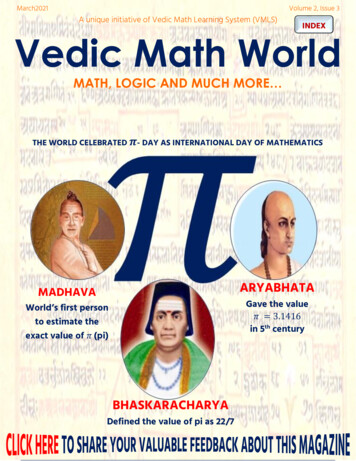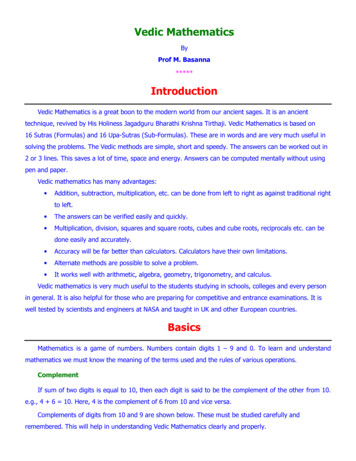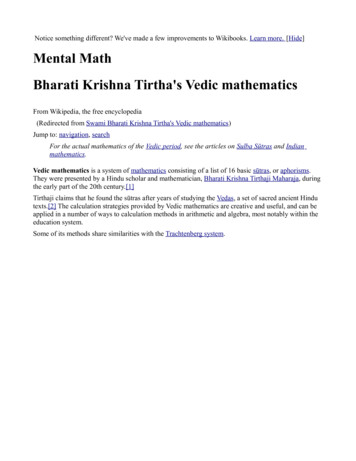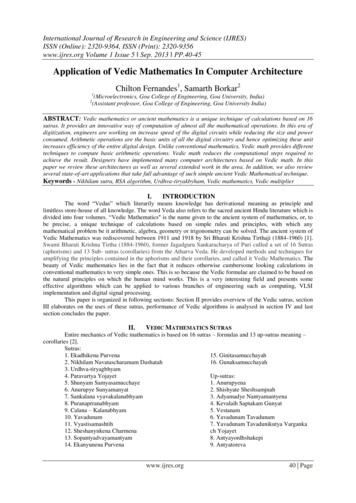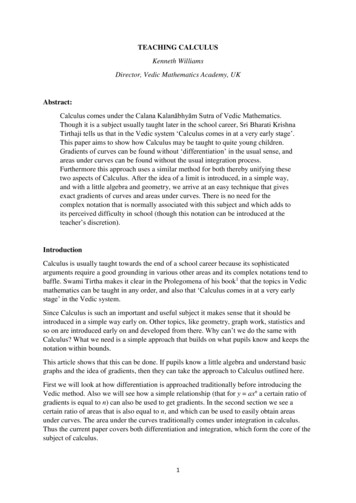
Transcription
TEACHING CALCULUSKenneth WilliamsDirector, Vedic Mathematics Academy, UKAbstract:Calculus comes under the Calana Kalanābhyām Sutra of Vedic Mathematics.Though it is a subject usually taught later in the school career, Sri Bharati KrishnaTirthaji tells us that in the Vedic system ‘Calculus comes in at a very early stage’.This paper aims to show how Calculus may be taught to quite young children.Gradients of curves can be found without ‘differentiation’ in the usual sense, andareas under curves can be found without the usual integration process.Furthermore this approach uses a similar method for both thereby unifying thesetwo aspects of Calculus. After the idea of a limit is introduced, in a simple way,and with a little algebra and geometry, we arrive at an easy technique that givesexact gradients of curves and areas under curves. There is no need for thecomplex notation that is normally associated with this subject and which adds toits perceived difficulty in school (though this notation can be introduced at theteacher’s discretion).IntroductionCalculus is usually taught towards the end of a school career because its sophisticatedarguments require a good grounding in various other areas and its complex notations tend tobaffle. Swami Tirtha makes it clear in the Prolegomena of his book1 that the topics in Vedicmathematics can be taught in any order, and also that ‘Calculus comes in at a very earlystage’ in the Vedic system.Since Calculus is such an important and useful subject it makes sense that it should beintroduced in a simple way early on. Other topics, like geometry, graph work, statistics andso on are introduced early on and developed from there. Why can’t we do the same withCalculus? What we need is a simple approach that builds on what pupils know and keeps thenotation within bounds.This article shows that this can be done. If pupils know a little algebra and understand basicgraphs and the idea of gradients, then they can take the approach to Calculus outlined here.First we will look at how differentiation is approached traditionally before introducing theVedic method. Also we will see how a simple relationship (that for y axn a certain ratio ofgradients is equal to n) can also be used to get gradients. In the second section we see acertain ratio of areas that is also equal to n, and which can be used to easily obtain areasunder curves. The area under the curves traditionally comes under integration in calculus.Thus the current paper covers both differentiation and integration, which form the core of thesubject of calculus.1
1. DIFFERENTIATION1.1 Modern Approach to DifferentiationThe modern approach to teaching differentiation is to introduce function notation and definea tangent gradient of a curve by:f (x) lim x 0f ( x x) f (x) xSo in addition to the function notation we have the special notation for limits and the notionof vanishing quantities like x, formed, confusingly, by two inseparable symbols.Then a diagram shows the set-up for a particular case, invariably y x2.yNext the definition is applied, giving:y x2f (x x) f (x) x 0 x2(x x) x 2 lim x 0 x2 x x ( x)2 lim x 0 x lim (2 x x)Q(x x, y y)f (x) lim yP(x, y) xx0 x 0 2xThis may work well for the older, and more mathematically sophisticated child, and of coursethe definition is general and so applies to all functions, but the alternative approach givennext is entirely suitable for younger children and introduces the concepts of limits andgradients much more simply.1.2 Vedic Approach to Differentiation1.2.1 LimitsChildren know about limits in their everyday life – they know there is a limit to the distancethey can throw a ball or the height they will grow to.BFrom here we can give mathematicalexamples: like what is the limit ofthe line AB as B moves towards,and merges into, C:A2C
secantPQOr the limit of the secantline PQ as Q approachesP around the circle,and merges into P:1.2.2 Secant of a ParabolaSuppose we have the simplest of mathematical curves: the parabola, described by theequationy x2.We can take two points on the curve, say where x 2 and x 5, and we can find the gradientof the secant that passes through them. Since the difference of the y-coordinates divided by25 4the difference of the x-coordinates is 5 2 we find the gradient to be 7.Further examples lead to the observation of a simple relationship between the twox-coordinates: that the sum of those x-coordinates gives the gradient. In this case 2 5 7,the gradient of the secant. We just use the Sutra By Addition.We can go on to prove this result. Given points on the parabola with x p and x q weexpect the gradient of the secant to be p q.We have: P(p, p2) and Q(q, q2) andp2 q2the gradient of PQ p q p – q p q p q p q.3
This approach can then be developed to find secant gradients for: y ax2,y ax2 bx c,y x3 and so on.The formula for the difference of two squares used above is well-known and very useful. Italso leads to further formulae for the difference of two cubes etc., which can be made use ofwhen finding secant gradients for other curves.We will stay with y x2 for the moment.1.2.3 Gradient of a CurveWe can discuss with pupils the idea of the gradient of a curve: that it varies, and that thegradient of the curve is the gradient of the tangent at that point.Coming back to the secant through PQ, suppose we let Q approach P around the curve. Thenthe secant ultimately becomes the tangent at P and the value of q approaches the value of p,and ultimately becomes equal to p.That means that since the secant gradient is p q, the gradient at P is p p 2p, or 2x sincep is an x-coordinate.Pupils need to understand the generality and limit of this result: that it is true for all points onthis particular parabola, but not necessarily true for any other curve. And they can confirmgraphically that the gradient is always twice the x-coordinate.This “secant-tangent method” (in which we find the secant gradient and then allow one of thepoints defining the secant to merge into the other) is extendible and can lead to the generalresult that for any polynomial the gradient formula can be found in the conventional way.dThat is, that: dxi n ai x i i 0i n a ixi 0ii -1.In the last step of the derivation of (p q) for the secant gradient, the cancelling ofp–qp qis notvalid when p q, but this can be explained as appropriate in terms of limits.This secant-tangent approach does not extend to other functions such as trigonometrical andexponential functions, but these can be tackled with alternative Vedic methods.4
1.2.4 ExtendingAfter studying the graphs of: y ax2,y ax2 bx c (here we demonstrate the distributive law for differentiation holds),y ax3 etc.in a similar way, we can look at negative indices: y 1x, y ax, y ax2etc.And then fractional indices: e.g. y2 5x3,which can lead into the chain rule, implicit differentiation and parametric equations.All of these can be treated in the way described above.ExampleTo find the gradient for y for P(p,1p) and Q(q,1q1x, for example, we find the difference of the y and x-coordinates).y1/qy 1xQP1/p01p q1p qpqqp1The secant gradient is p q – p q – pq .Then in the limit, as Q P, the tangent gradient is –11p2 –1x2.So simple curves like y x2, y x etc. have tremendous potential for teaching thefundamentals of differentiation – finding gradients of curves using a limiting process.5x
1.3 Ratio of GradientsHere we have an alternative relationship that we will later connect with a similar ratio forareas under curves.There are in fact two gradients associated with any point on a curve:1) the gradient of the tangentto the curve at that point,2) the gradient of the linejoining the point to the origin.And for y axn, where n is rational and a is a real number:The ratio of these gradients is n.dy /dxdySo we have: ratio of gradients y / x n, which means that dx n yx.1.3.1 Proof that the Ratio of Gradients nGiven yu axv, where u, v , and a ax v -1ydyvdy, we have uyu-1 dx avxv-1.yAnd since x u-1 , then dx u x .yThis result comes under the Sutra If One is in Ratio the Other is Zero. It can also be derivedusing the “secant-tangent method” given earlier. ItExample: Find the gradient of y 2x3 at the point (3, 54).dyWe note n 3 and so: dx 3 543 54.Example: And to find the gradient of y2 4x3 at the point (4, 16),we note n 32and so:dy316dx 2 4 6.6
For comparison with the contemporary method the corresponding solution to the lastexample above would be:dy2y dx 12x2dy6x 2 ydxdy96dx 16 6.1.3.2 Classroom ApproachThis ratio of gradients can be approached in the classroom:a) graphically, for example for y 1xthe ratio of gradients is -1,yy For y 1xx0the Ratio of Gradients -1b) by algebraic calculation of the ratio for specific cases,c) algebraically to verify the general conclusion.It is very motivating to see a conjecture suggested from a graph verified algebraically or viceversa.7
2. AREAS UNDER CURVES2.1 Modern Approach to Areas under CurvesFirst, integration is defined as the reverse of differentiation. Then various methods are used toshow that an integral (or anti-derivative) of a function defines an area under that function.We may argue as follows.Let A(x) the area under y f(x)from x a to x x, where A(a) 0.Then the area of the shaded stripon the right A(x x) - A(x) x f(x).ThereforeBut lim x 0A(x x) A(x) f(x). xA(x x) A(x) A ( x) , therefore in the limit A ( x) f(x). xAnd if A ( x) f(x) then A xaf (x)dx .The full argument is not given here due to lack of space, but we see that we can find areasunder y f(x) by integrating f(x), substituting the limits and subtracting.Next we look at an alternative approach that can be easily grasped by young children.2.2 Vedic Approach to Areas under Curves2.2.1 Ratios of AreasTake a pair of axes and from theorigin draw a straight line as shown,with any gradient.Select any point on the line and dropperpendiculars onto the two axes, as also shown.The two triangles generated will beequal in area, and this will apply forany straight line chosen: the ratio ofareas will be 1:1.8
Now suppose we wish to draw a line, starting at the origin, but the requirement is that theratio of areas similarly generated will be 2:1 rather than 1:1.The line must clearly be a curve, rather than a straight line.Also its gradient must be increasing if the area to the left of the line is to be double the areaunder it.What will be the equation of the curve that has this special property?yy x22Well, it turns out that theanswer is the parabola given by y x2.1In fact any of the parabolas givenby y ax2 will have this property.We will demonstrate this result shortly.x0This means that the area indicated by ‘1’ above is one third of the total area, and area ‘2’ willbe two thirds of the total rectangle.Example: Suppose we want the area under y x2 from x 0 up to x 4.yy x2We can find the area of therectangle and find one third of that.2The height of the rectangle is42 16, so the rectangle area is 4 16 64.104x641And the required area will therefore be 3 64 3 .In fact we can see that the area is one third of the cube of the x-coordinate.This is just simple Proportion.2.2.2 Area of a StripSimilarly we can find the area of a strip A, like the area from x 2 to x 3 shown below.yy x2Since we can find the areafrom the origin up to x 3and also the area up to x 2,A9023 x
we can find the difference of these,which will be the required area.So we need338192327–33 3 – 3 3 .19We get the area as 3 .We simply subtract the cubes of the two x-values, and divide by 3.2.2.3 ExtendingWe can also use symmetry in various ways to extend our range of techniques.And we can extend to: y ax2 bx c where we have a difference of cubes,difference of squares and difference of x-coordinates, y ax3 where the ratio of areas is 3:1, y2 ax3 where the ratio of areas is 3:2. y And in general for y axn, n a, x 0, where the ratio will be 2:1 (since areas are always positive).x2, a , the ratio is n:1.So for y axn:The ratio of these areas is n.2.2.4 Explanation of Ratio of Areas n for y x2We can show that the ratio of areas for y x2 is 2:1 as follows.BThat is, show that A 2,where A is the value of the area betweenthe curve, the x-axis and the lines x pand x q.And B is the value of the corresponding area,as shown.The explanation follows similar linesto that for the gradient of a curve inasmuch10
as we take two points P(p, p2), Q(q, q2), express the ratio of areas approximately and then letq p.We approximate areasA and B with the rectangles shownshaded.The ratio of these areas isyy x2Pp2Bq2Qq ( p q )BA ( p q )q22 2Ap qq ,0qpx2pwhich in the limit goes to p 2.This shows that as the horizontal and vertical strips get narrower and narrower the ratio of theareas approaches 2:1, and ultimately equals 2:1.And since the ratio of areas is independent of x, it applies to all such strips.Now any area to the left of y x2 andbounded by two horizontal lines andthe y-axis (like area B) can be splitinto a large number of strips as shown.And since the ratio of areas of two corresponding strips (one horizontal and one vertical) isultimately 2:1, therefore the ratio of the whole area consisting of a collection of strips on theleft, to the corresponding area below the curve will also be 2:1.This shows that any area B in y x2 is double the corresponding area A.2.2.5 GENERAL PROOF THAT Ratio of Areas nGiven y axn, where n p, q .Then A pqydx p axq, a, x ndx, take points on the curve P(p, apn) and Q(q, aqn), ax n 1 n 1 p, n -1*.q11
And B apaqnnx dy apaqnnya1ndy an y 1n 1 n 1 a apn, n -1.aq n n nn 1 n nn 1 p q pn 1 qn 1 BnnSo A pn 1 qn 1 .pn 1 - qn 1 pn 1 qn 1 And lim n n 1 n 1 n. p q q p* The case where n -1 is straightforward.3. SUMMARY and Concluding RemarksWe have seen that we can use limiting arguments to obtain the gradient of curves given byy axn and to obtain areas under them. Compared to traditional approaches this has certainadvantages, notably that calculus can be taught to quite young students.The secant-tangent method, and the memorable result that Ratio of Gradients Ratio ofAreas n enable us to easily get gradients of a range of curves and areas under them.By restricting the study to curves of the form y axn pupils can be exposed to the mainprinciples of calculus at a young age, so that the understanding and development of thissubject becomes a lot smoother, and a good foundation is prepared for the more advancedwork which may follow.This way pupils get the opportunity to develop and apply skills in algebra, limits etc. Thenecessary notation can be introduced as appropriate at the discretion of the teacher. ‘Vedic’methods for more advanced work (like the product rule, chain rule, differential equations etc.)are also available so this approach can be developed further, and merged with theconventional approach at any point.Reference[1] Bharati Krsna Tirthaji Maharaja, “ Vedic Mathematics”, Motilal Banarasidas Publisher,Delhi, 1994.12
Director, Vedic Mathematics Academy, UK Abstract: Calculus comes under the Calana Kalanābhyām Sutra of Vedic Mathematics. Though it is a subject usually taught later in the school career, Sri Bharati Krishna Tirthaji tells us that in th




